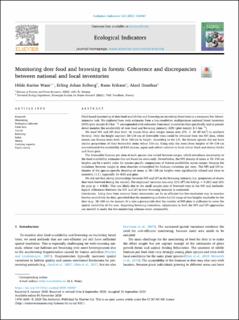| dc.contributor.author | Wam, Hilde Karine | |
| dc.contributor.author | Solberg, Erling Johan | |
| dc.contributor.author | Eriksen, Rune | |
| dc.contributor.author | Granhus, Aksel | |
| dc.date.accessioned | 2021-07-21T07:38:55Z | |
| dc.date.available | 2021-07-21T07:38:55Z | |
| dc.date.created | 2021-01-25T18:22:23Z | |
| dc.date.issued | 2021-01 | |
| dc.identifier.citation | Ecological Indicators. 2021, 120 . | en_US |
| dc.identifier.issn | 1470-160X | |
| dc.identifier.uri | https://hdl.handle.net/11250/2764849 | |
| dc.description.abstract | Field-based monitoring of deer food availability and browsing on recruiting forest trees is a necessary but labour-intensive task. We explored how such estimates from a low-resolution multipurpose national forest inventory (NFI) (plot density 0.3 km−2) corresponded with estimates from local inventories that specifically and in greater detail monitor the availability of deer food and browsing intensity (LFI) (plot density 2–3 km−2). We used NFI and LFI data from 16 moose Alces alces ranges (mean area 276 ± SE 69 km2) in southern Norway. Only the height segment 30–130 cm of browsable trees could be obtained from the NFI data, while moose can browse trees from 30 to 300 cm in height. According to the LFI, the browse species did not have similar proportions of their browsable stems below 130 cm. Using only the stems from heights of 30–130 cm overestimated the availability of RAS (rowan, aspen and sallow) relative to birch (silver birch and downy birch) and Scots pine. The browsable biomass per stem of each species also varied between ranges, which introduces uncertainty to the food availability estimates that are based on stems only. Nevertheless, the NFI density of stems at 30–130 cm heights can be a useful index for species-specific comparisons of browse availability across ranges, because the variations between ranges in stem densities outweighed the biomass variations per stem. The NFI and LFI estimates of the species-specific densities of stems at 30–130 cm heights were significantly related and close to isometric (1:1), especially for RAS and pine. We did not find strong relationships between NFI and LFI in the browsing intensity (i.e. proportion of shoots that were browsed during the winter). The explained variation was only 11% (R2) for RAS (p = 0.281) and 32% for pine (p = 0.028). This was likely due to the small sample sizes of browsed trees in the NFI and methodological differences between the NFI and LFI in how browsing intensity is estimated. Conclusions Using data from national forest inventories can be an efficient but low-resolution way to monitor browse availability for deer, provided that the monitoring includes the full range of tree heights reachable for the deer (e.g., 30–300 cm for moose). It is also a prerequisite that the number of NFI plots is sufficient to cover the spatial variability of the area. Regarding browsing intensities, adjustments in both the NFI and LFI approaches are needed to make the two monitoring schemes more comparable. | en_US |
| dc.language.iso | eng | en_US |
| dc.publisher | Elsevier Ltd. | en_US |
| dc.rights | Attribution-NonCommercial-NoDerivatives 4.0 Internasjonal | * |
| dc.rights.uri | http://creativecommons.org/licenses/by-nc-nd/4.0/deed.no | * |
| dc.title | Monitoring deer food and browsing in forests: Coherence and discrepancies between national and local inventories | en_US |
| dc.type | Peer reviewed | en_US |
| dc.type | Journal article | en_US |
| dc.description.version | publishedVersion | en_US |
| dc.rights.holder | © 2020 The Author(s) | en_US |
| dc.source.pagenumber | 11 | en_US |
| dc.source.volume | 120 | en_US |
| dc.source.journal | Ecological Indicators | en_US |
| dc.identifier.doi | 10.1016/j.ecolind.2020.106967 | |
| dc.identifier.cristin | 1878984 | |
| dc.source.articlenumber | 106967 | en_US |
| cristin.ispublished | true | |
| cristin.fulltext | original | |
| cristin.qualitycode | 1 | |

